Td/IPV vaccine coverage for the NHS adolescent vaccination programme in England, academic year 2022 to 2023
Updated 17 February 2025
Applies to England
Main points
This report presents vaccine coverage data for the routine school-aged diphtheria, tetanus and inactivated poliomyelitis (Td/IPV) immunisation programme in England for the 2022 to 2023 academic year. These results include Td/IPV vaccine coverage estimates for children in years 9 and 10 (or the equivalent ages) measured up to the 31 August 2023.
The main findings of this report are that:
- Td/IPV coverage for year 9 students during the 2022 to 2023 academic year was 68.3%, which is 0.7 percentage points lower than the year 9 cohort in 2021 to 2022 (Figure 1)
- Td/IPV coverage for year 10 students during 2022 to 2023 was 74.1%, which is 5.4 percentage points lower than the year 10 cohort in 2021 to 2022 (Figure 1)
- Td/IPV coverage in year 10 students was 5.1 percentage points higher than in 2021 to 2022 when they were in year 9
- Td/IPV coverage in year 9 students was highest in the South East (74.9%) and lowest in London (60.4%)
Introduction
Tetanus, diphtheria and polio vaccines are offered to all babies with the other primary immunisations at 8 weeks, 12 weeks and 16 weeks. A pre-school booster is then offered to children at 3 years and 4 months of age, and a school leaver booster (Td/IPV) is offered to adolescents aged 14 years (1). The school leaver booster is therefore the fifth dose of a tetanus, diphtheria and polio containing vaccine in the routine immunisation schedule and completes the course, providing long-term protection against all 3 infections (1, 2, 3, 4).
Any missed doses of diphtheria, tetanus and polio vaccines can be caught up at any age observing the appropriate intervals between doses as detailed in the Green Book. NHS England (NHSE) commissions general practices and/or school-age immunisation providers to deliver the routine childhood immunisation programmes in England.
The NHS adolescent immunisation programmes in England are primarily school based and are delivered routinely by NHSE commissioned school-age vaccination providers. Adolescents who are home schooled, those who attend a small minority of schools that do not offer the routine vaccination programmes, and those eligible, but not in education, should be offered their vaccinations in alternative settings, such as community clinics. Data on whether children were vaccinated in school or at alternative settings is not universally included in the school vaccination figures submitted by data providers.
In 2021 to 2022, the routine offer of Td/IPV vaccine to the year 9 cohort was implemented alongside catch-up for the year 10 cohort in most local authorities. Only a small number of NHSE commissioned school-aged immunisation providers, covering 4 local authorities, continue to offer the Td/IPV programme to year 10 students routinely.
Since March 2020, the coronavirus (COVID-19) pandemic has led to some disruption of school-based immunisation programme delivery and the impact has varied by region and local authority. The biggest impact was observed in the 2019 to 2020 academic year when all schools were closed in the first national lockdown (5). Throughout 2020 to 2021, school attendance rates in England were lower than normal. In January 2021, schools were closed to all, except children of keyworkers and vulnerable children, with a phased reopening of secondary schools from March 2021. Staff absences in both schools and school aged immunisation services (SAIS) also added to the disruption.
Vaccine coverage in 2020 to 2021 improved significantly but was still not back up to pre-pandemic levels. In 2021 to 2022, school attendance rates in England remained lower than normal until the ‘Living with COVID-19’ guidance was implemented from February 2022 and all restrictions were lifted (6). In September 2021, the offer of COVID-19 vaccination was extended to all children aged 12 to 15 years and was delivered in secondary schools and other settings (7). In addition, the influenza immunisation programme was extended to all children in secondary schools (8). School-aged immunisation services (SAIS) were instrumental in supporting the delivery of all of these programmes under very challenging circumstances. It is likely that all of these factors, combined, impacted on the delivery of the routine adolescent immunisation programmes, including the Td/IPV programme.
Previous reports were published by Public Health England (PHE).
Methods
NHSE-commissioned school aged immunisation providers collect school-level vaccine coverage data, which is then aggregated up to local authority and submitted to the UK Health Security Agency (UKHSA) either directly by the providers or by NHSE Regional Public Health Commissioning Teams via the ImmForm website. Where possible, regional teams also include additional data for adolescent’s resident in the local authority but not linked to any school. Data providers may also submit data on vaccinations delivered through community clinics or GP practices and this can then be added to the school vaccination figures.
The numerator is defined by the number of adolescents in each cohort who had received a dose of the Td/IPV vaccine by 31 August 2023. Providers must use updated data sources to identify all eligible children in the locality for the academic year. This can be calculated from school student records for all types of schools or units, plus children schooled at home, or Child Health Information Systems.
The denominator is defined by the total number of eligible adolescents in each cohort regardless of programme delivery.
Local authority level Td/IPV vaccine coverage data up to 31 August 2023 was manually uploaded by data providers to the ImmForm website from 1 September 2023 to 1 October 2023. The target population for the programme is defined by school age cohorts born between 1 September 2007 and 31 August 2009 (Table 1). This means that it includes those adolescents in school years 9 and 10 in the 2022 to 2023. Coverage for the year 10 cohort was intended to capture both vaccines delivered during 2021 to 2022 (when the students were in year 9) and routine or catch-up vaccines delivered in 2022 to 2023.
Full details of the data collection process and definitions can be found in the user guide.
Table 1. Td/IPV vaccination cohorts in the 2022 to 2023 academic year
| School year in 2022 to 2023 | Age in 2022 to 2023 | Dates of birth |
|---|---|---|
| 9 (routine) | 13 to 14 years | 1 September 2007 to 31 August 2008 |
| 10 (routine or catch-up) | 14 to 15 years | 1 September 2007 to 31 August 2008 |
Results
Figure 1 shows the Td/IPV vaccine coverage for year 9 (dark teal) and year 10 (cyan) students in England from 2015 to 2023. This data is also presented in text form in Table 2. Td/IPV coverage for year 9 students during 2022 to 2023 was 68.3%, which is 0.7 percentage points lower than the year 9 cohort in 2021 to 2022. For year 10 students, coverage was 74.1% in 2022 to 2023, which is 5.4 percentage points lower than the year 10 cohort in the previous year.
Figure 1. Td/IPV coverage in adolescents in school years 9 and 10 by academic year from 2015 to 2023
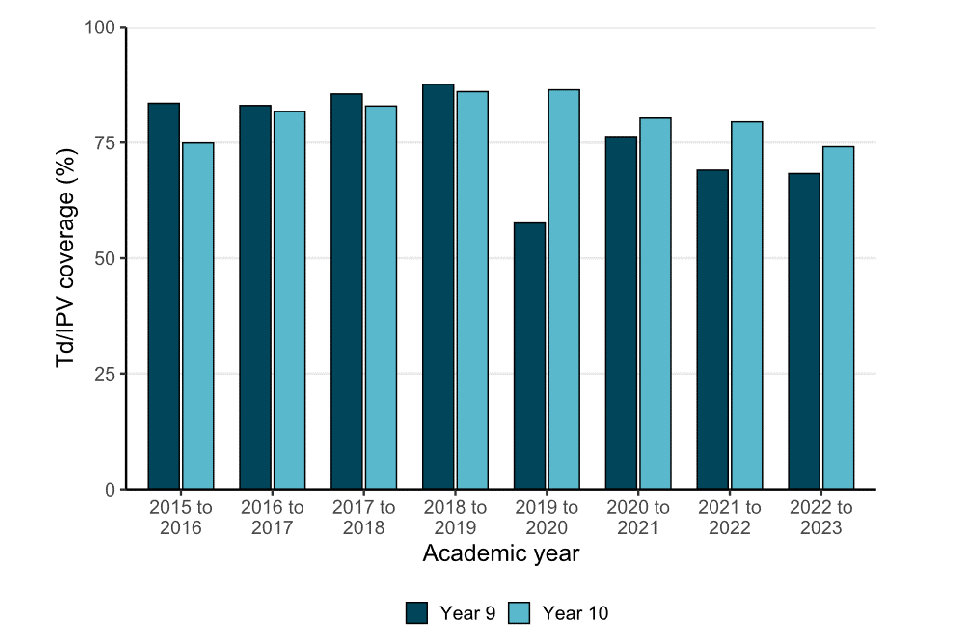
Table 2. Td/IPV coverage in years 9 and 10 from 2015 to 2023 [Note 1]
| Academic year | Year 9 Td/IPV coverage (%) | Year 10 Td/IPV coverage (%) |
|---|---|---|
| 2015 to 2016 | 83.5 | 74.9 |
| 2016 to 2017 | 83.0 | 81.7 |
| 2017 to 2018 | 85.5 | 82.9 |
| 2018 to 2019 | 87.6 | 86.0 |
| 2019 to 2020 | 57.6 | 86.4 |
| 2020 to 2021 | 76.3 | 80.3 |
| 2021 to 2022 | 69.0 | 79.5 |
| 2022 to 2023 | 68.3 | 74.1 |
Note 1. In 2015 to 2016, only half of the year 9 and 10 cohorts were eligible for the vaccine meaning these figures are not comparable to later years. Also, over time many local authorities have moved from routinely offering the vaccine in year 10 to offering it in year 9. During transitional years, some local authorities offered the vaccine routinely to both year 9 and 10. This transition meant that in 2018 to 2019, the year 9 data was incomplete meaning some local authorities were excluded from national coverage figures. Since almost all local authorities now offer the vaccine in year 9, the year 10 coverage figures in 2021 to 2022 are the year 9 coverage plus additional catch-up. These changes mean that national coverage figures are not directly comparable over time and explain why coverage in the year 10 cohort may appear to decrease when compared to previous years.
Programme delivery
Year 9 vaccine coverage
The main findings for the year 9 cohort were that:
- Td/IPV coverage for year 9 students in 2022 to 2023 was 68.3%, which is 0.7 percentage points lower than year 9 students in the previous year (Table 2)
- Td/IPV coverage in year 9 students was highest in the South East (74.9%) and lowest in London (60.4%) (Figure 2)
- local authority level coverage ranged from 92.4% (West Berkshire) to 0.3% (Greenwich) (this range includes those who only offer the vaccine routinely in year 10)
- out of 151 local authorities, coverage in 75 (49.7%) was less than 70%, coverage in 49 (32.5%) was between 70% and 80%, coverage in 24 (15.9%) was between 80% and 90%, and coverage in 3 (2.0%) was greater than 90%
Figure 2 shows the distribution of Td/IPV vaccine coverage in school year 9 by NHS Commissioning region. Vertical black lines indicate the range of values among constituent upper tier local authorities (UTLAs) in each region, while the teal boxes indicate the range of the second to third percentiles, with the median indicated by the horizontal white line within each box. Td/IPV coverage in year 9 students was highest in the South East (74.9%) and lowest in London (60.4%).
Figure 2. Year 9 Td/IPV coverage by NHS commissioning region
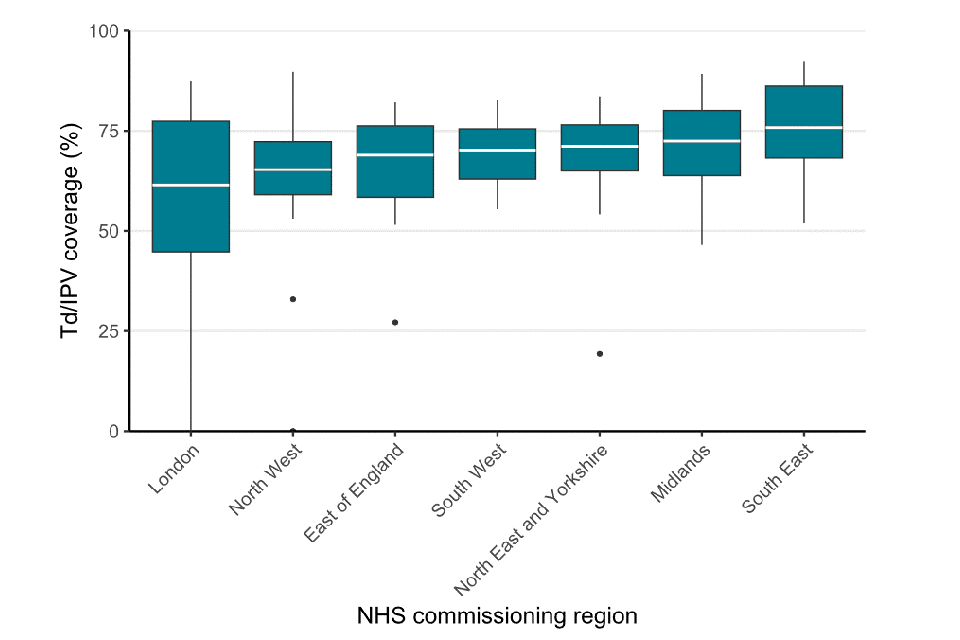
Figure 3 shows the geographical distribution of Td/IPV vaccine coverage at the UTLA level for year 9 students in England. Coverage within UTLAs ranged from 92.4% in West Berkshire to 0.3% in Greenwich (this range includes UTLAs who only offer the vaccine routinely in year 10).
Figure 3. Map of year 9 Td/IPV coverage by local authority
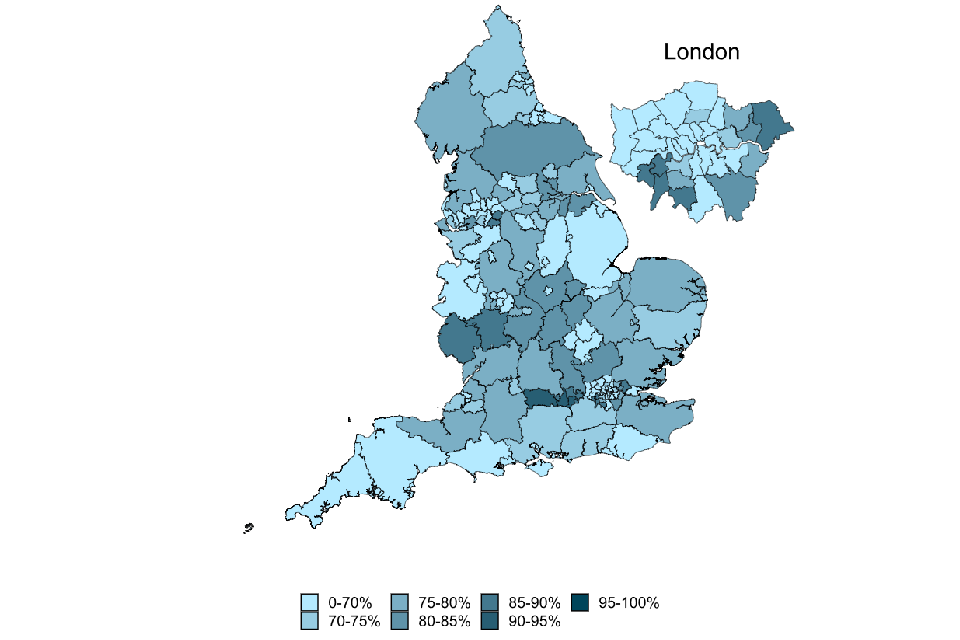
Year 10 vaccine coverage
The main findings for the year 10 cohort were that:
- Td/IPV coverage for year 10 students in 2022 to 2023 was 74.1%, which is 5.4 percentage points lower than year 10 students in the previous year (Table 2)
- Td/IPV coverage in year 10 students was 5.1 percentage points higher than in 2021 to 2022 when they were in year 9 (Table 2) suggesting ongoing catch-up activities
- Td/IPV coverage in year 10 students was highest in the East of England (91.5%) and lowest in London (65.4%) (Figure 3)
- local authority level coverage ranged from 97.8% (Central Bedfordshire) to 41.6% (Leicester)
- out of 151 local authorities, coverage in 65 (43.0%) was less than 70%, coverage in 36 (23.8%) was between 70% and 80%, coverage in 35 (23.2%) was between 80% and 90%, and coverage in 15 (9.9%) was greater than 90%
Figure 4 shows the distribution of Td/IPV vaccine coverage in school year 10 by NHS Commissioning region. Vertical black lines indicate the range of values among constituent UTLAs in each region, while the teal boxes indicate the range of the second to third percentiles, with the median indicated by the horizontal white line within each box. Td/IPV coverage in year 10 students was highest in the East of England (91.5%) and lowest in London (65.4%).
Figure 4. Year 10 Td/IPV coverage by NHS commissioning region
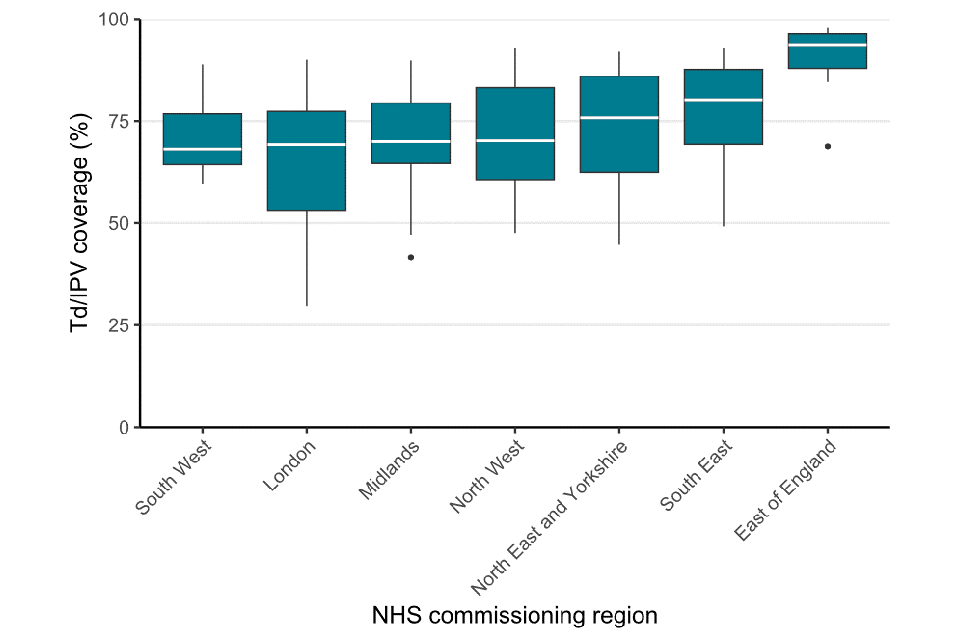
Note. Data for Lewisham has been excluded from the data set because of poor data quality.
Figure 5 shows the geographical distribution of Td/IPV vaccine coverage at the UTLA level for year 10 students in England. Coverage within UTLAs ranged from 97.8% in Central Bedfordshire to 41.6% in Leicester.
Figure 5. Map of year 10 Td/IPV coverage by local authority
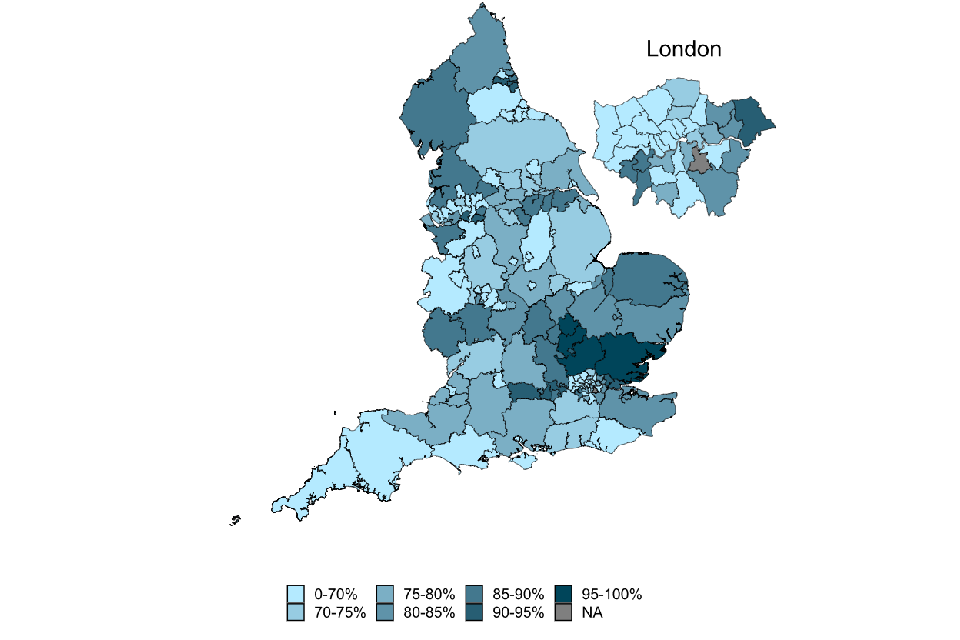
Discussion
Td/IPV vaccine coverage for year 9 in 2022 to 2023 was 68.3%. This is slightly lower than coverage in 2021 to 2022 and not yet back to pre-pandemic levels. Coverage in the year 10 cohort was 74.1%, which is no improvement on uptake recorded for this cohort in year 9 during the previous academic year. When coverage was calculated for each NHS commissioning region, the estimates varied considerably.
References
1. PHE (2020). Routine childhood immunisations from autumn 2019 (born up to and including 31 December 2019)
2. PHE (2013). Polio: the Green Book, chapter 26
3. PHE (2013). Tetanus: the Green Book chapter 30
4. PHE (2013). Diphtheria: the Green Book, chapter 15
5. Department for Education (DfE) (2021). Attendance in education and early years settings during the coronavirus (COVID-19) pandemic (November)
6. DfE (2022). Attendance in education and early years settings during the coronavirus (COVID-19) pandemic (July)
7. Department of Health and Social Care (DHSC) (2021). Universal vaccination of children and young people aged 12 to 15 years against COVID-19
8. DHSC (2021). National flu immunisation programme 2021 to 2022 letter
